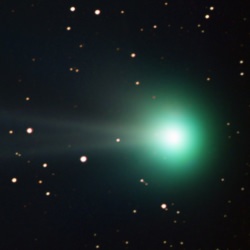
Comet Pojmanski by R. Jay GaBany
Set your alarm clocks between 4:30 and 5:00AM sometime over the next two or three days because a bright new comet that can be seen with the unaided eye, even better through binoculars, is dancing head first near the horizon almost due east before sunrise. The comet is named Pojmanski and has been given the official designation of C/2006 A1. It was discovered earlier this year on January 2.
Grzegorz Pojmanski, of the Warsaw University Astronomical Observatory in Poland, first spotted this comet in a photograph taken from Chile when it glowed around magnitude 12 – thousands of times too faint to be seen visually without telescopic aide.
As the comet has moved closer to Earth on a journey that will swing it around the sun, its actual brightness has surpassed all original estimates so that by the morning of March 3, it was still between magnitude 5.5 and 6. That makes it as visible as any of the stars in the Little Dipper. The comet’s closest approach to Earth is on March 5 when it will be about 62 million miles away. It should become easier to spot until March 8, because it will rise earlier and earlier in the morning but it will also become dimmer.
The comet is now a pre-dawn object that rises almost directly in the east a few minutes before 4AM – left of a dazzling white star that is actually the planet Venus. It appears as a tiny star when viewed straight on but through binoculars, a tail that points away from the direction of sunrise is evident. Each day it will rise earlier than the previous and by March 8, Comet Pojmanski will have risen to a fourth of the distance between the horizon and directly overhead at the start of dawn.
I took this image on the morning of March 3, 2006 from my remotely controlled observatory in south central New Mexico located at an elevation of about 7,200 feet above sea level. I combined twelve separate images taken through red, green and blue filters to create this full color portrait. Digital processing enabled me to freeze the comet’s motion that occurred during the thirty-minute exposure period. The picture was taken through a twenty inch Ritchey-Chretien telescope with an eleven-mega pixel camera specially designed for astronomical imaging.
Do you have photos you’d like to share? Post them to the Universe Today astrophotography forum or email them, and we might feature one in Universe Today.
Written by R. Jay GaBany
